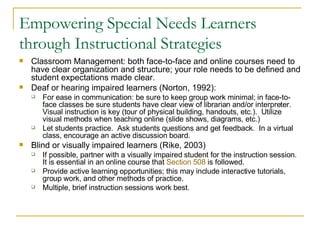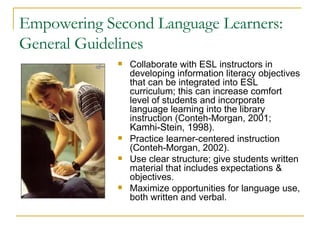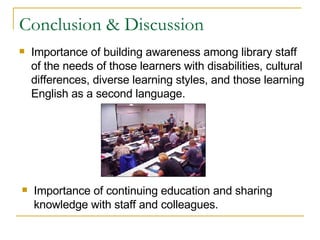Best Practices: Library Instruction for Diverse Learners
- 1. Best Practices: Library Instruction for Diverse Learners Rebecca Blakiston http://steadfastlibrarian.wordpress.com
- 2. Empowering Special Needs Learners: General Guidelines Advocate for universal design: “Universal design means that rather than designing your facility and services for the average user, you design them for people with a broad range of abilities, disabilities, and other characteristics-people with a variety of ages, reading abilities, learning styles, languages, cultures, etc.” (Equal Access, 2007) Cornell Library renovated to make its lower level room universally accessible Aim for universal access to information in printed and electronic forms as well as access to library events, exhibits, etc. A great checklist is available through the University of Washington, Equal Access: Universal Design of Libraries .
- 3. Empowering Special Needs Learners through Accessibility If using podcasting or other audio methods, be sure to also transcribe the content; also work to make available audio access to electronic resources (Jax, 1993). When possible, have library research guides and other materials translated into large font and Braille (Graubart, 1996). Make sure websites and online tutorials fit the criteria outlined in Section 508 . A number of tools and resources are available to aid us in adhering to accessibility principles. Two key components of an accessible web page are: The use of proper ALT tags on all images Organization of content so it can be read by speech output software A Web Accessibility Toolbar is available as a free download for simple evaluation of web page accessibility. See details on this toolbar as described by California State University at Northridge’s Oviatt Library .
- 4. Empowering Special Needs Learners through Technology Advocate for the availability of adaptive and assistive technology in your library Technology examples include: Kurzweil text-to-speech software , JAWS screen reading software , ZoomText magnification software Adaptive Technology Workstation available at MIT Libraries
- 5. Empowering Special Needs Learners through Instructional Strategies Classroom Management: both face-to-face and online courses need to have clear organization and structure; your role needs to be defined and student expectations made clear. Deaf or hearing impaired learners (Norton, 1992): For ease in communication: be sure to keep group work minimal; in face-to-face classes be sure students have clear view of librarian and/or interpreter. Visual instruction is key (tour of physical building, handouts, etc.). Utilize visual methods when teaching online (slide shows, diagrams, etc.) Let students practice. Ask students questions and get feedback. In a virtual class, encourage an active discussion board. Blind or visually impaired learners (Rike, 2003) If possible, partner with a visually impaired student for the instruction session. It is essential in an online course that Section 508 is followed. Provide active learning opportunities; this may include interactive tutorials, group work, and other methods of practice. Multiple, brief instruction sessions work best.
- 6. Empowering Second Language Learners: General Guidelines Collaborate with ESL instructors in developing information literacy objectives that can be integrated into ESL curriculum; this can increase comfort level of students and incorporate language learning into the library instruction (Conteh-Morgan, 2001; Kamhi-Stein, 1998 ). Practice learner-centered instruction (Conteh-Morgan, 2002). Use clear structure; give students written material that includes expectations & objectives. Maximize opportunities for language use, both written and verbal.
- 7. Empowering Second Language Learners through Instructional Strategies When communicating verbally, use longer pauses between semantic groups; enunciate more clearly, and opt for restatement of ideas and reformulation of sentences rather than repetition (Conteh-Morgan, 2002). When possible, use auditory material in an online course so students can hear the spoken language. Utilize authentic teaching methods; use clear & multiple examples that draw links to the real world. Ask questions to the audience and allow time for them to ask you questions. In virtual learning, utilize discussion boards for this purpose. Have students work with partners on activities to discuss the material. Online, this may mean making chat sessions available. Encourage students to take notes and summarize what they have learned in their own words. Having them write a journal or blog is a good way to do this.
- 8. Empowering Second Language Learners in Library Instruction Talk through examples of search methodologies and involve the students in the process. The discovery process is important. Allow the students time to practice searching on their own, making yourself available for assistance. When instructing on database and catalog use, demonstrate how to use different languages or switch characters as needed.
- 9. Empowering Learners with Cultural Differences: General Guidelines Mechanical and affective barriers have been found to be the two greatest sources of “library anxiety” for international students; understand the implications of this and try to reduce these anxieties in your instruction sessions (Jiao, 2001). Be cognizant that information-seeking behavior can vary among different ethnic and cultural groups (Liu, 1995) and that students from developing countries will likely have difficulties in understanding and using the library (Liu, 1993). Embrace diversity by allowing students to learn about one another’s culture by integrating it into the lesson.
- 10. Empowering Learners with Cultural Differences through Instructional Strategies Allow students to express their own research interests and understanding of the topics. Discuss and embrace different perspectives in the classroom. In face-to-face and online discussions, be sure that respect and civility is maintained at all times. Use a range of strategies to reach all types of learners; maintain learner-centeredness and adjust the lesson as necessary.
- 11. Empowering Learners with Cultural Differences in Library Instruction In database or catalog searching classes, ask for suggestions of search terms by the audience. Ask for alternate search terms. In an online tutorial, allow students to choose their own topics to practice searching. If you are teaching students how to evaluate websites for bias, ask that they look up a topic from the perspective of two different cultures and notice any differences they find. If your lesson falls around the time of a cultural holiday, demonstrate searching for information on that holiday. You could also provide a list of web resources to students that contains reliable information. Dia de los Muertos altar exhibit
- 12. Empowering Learners with Different Learning Styles: General Guidelines Online courses can also utilize these different learning styles through new technology. Learning styles (VARK): Visual, Aural, Reader/Writer, Kinesthetic Most students are multi-modal and learn in a variety of ways. Try incorporating all different approaches in your lessons: “Multi-Sensory Teaching Style” (Applin, 1999).
- 13. Empowering Learners with Different Learning Styles through Technology Visual: slide shows, diagrams, pictures, visual aids, handouts/downloads Jing Project , Sketchcast , SlideShare , SlideAware , Picnik , Splashcast , YouTube , Screencast-O-Matic , etc. Aural: podcasting, voiceover, chat, lectures Audacity , Skype Readers/Writers: written instructions, opportunities to write individually and collaboratively Wikispaces , WordPress , Zoho Kinesthetic: interactive tutorials, real world practice Captivate , Demofuse , Second Life
- 14. Conclusion & Discussion Importance of building awareness among library staff of the needs of those learners with disabilities, cultural differences, diverse learning styles, and those learning English as a second language. Importance of continuing education and sharing knowledge with staff and colleagues.
- 15. Resources from the Literature Applin, M.B. (1999). Instructional Services for Students with Disabilities. Journal of Academic Librarianship, 25(2), 139-141. Conteh-Morgan, M. (2001). Empowering ESL Students: A New Model for Information Literacy Instruction. Research Strategies, 18(1), 29-38. Conteh-Morgan, M. (2002). Connecting the Dots: Limited English Proficiency, Second Language Learning Theories, and Information Literacy Instruction. Journal of Academic Librarianship , 28(4), 191-196. Jax, J. and Muraski, T. (1993). Library Services for Students with Disabilities at the University of Wisconsin-Stout. Journal of Academic Librarianship, 19 (3), 166-168. Jiao, Q.G. and Onwuebguzie, A. (2001). Sources of Library Anxiety among International Students. Urban Library Journal, 11(1), 16-27. Kamhi-Stein, L.D. and Stein, A. (1998). Teaching Information Competency as a Third Language: A New Model for Library Instruction. Reference and User Services Quarterly, 38(2), 173-179. Liu, Z. (1993). Difficulties and Characteristics of Students from Developing Countries in Using American Libraries. College and Research Libraries, 54, 25-31. Liu, M. (1995). Ethnicity and Information Seeking. The Reference Librarian, 49/50, 123-134.
- 16. Web Resources Education World: Diversity in Education Center, http://www.education-world.com/a_diversity/ Learning Disabilities Association, http:// www.ldaamerica.org / Section 508, http://www.section508.gov/ . University of Washington. Equal Access: Universal Design of Libraries, http://www.washington.edu/doit/Brochures/Academics/equal_access_lib.html . VARK: A Guide to Learning Styles, http://www.vark-learn.com/english/index.asp Vision Australia, Blind and Low Vision Services. Web Accessibility Toolbar, http:// www.visionaustralia.org.au/ais/toolbar /















